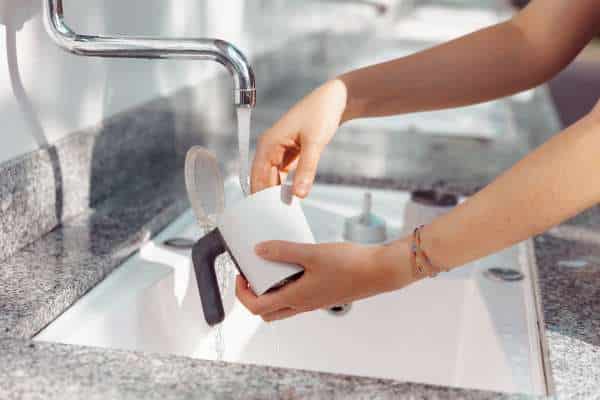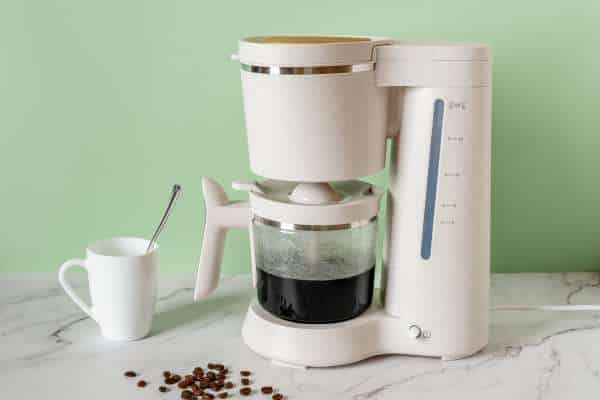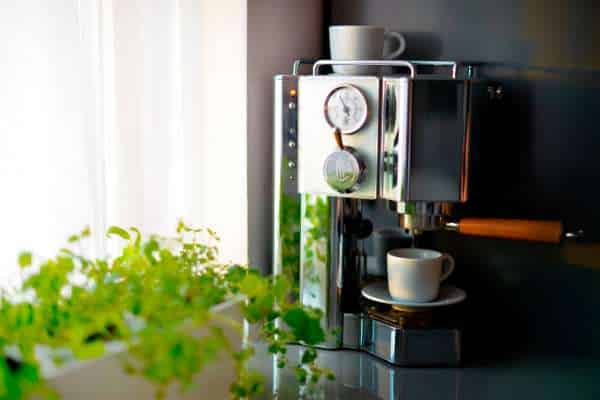Your love for Joe knows no bounds – from indulging in that first invigorating sip to relying on its caffeine kick throughout the day. But have you ever wondered about the secret life brimming inside your trusty Joe maker? Chances are, it’s been silently accumulating residue from countless brewing sessions, gradually diminishing the quality of each cup. Fear not! We’re here with a simple solution: baking soda. This unassuming white powder has remarkable cleaning properties that can restore your machine to its former glory. Join us as we delve into the world of Joe machine maintenance And discover how to clean a coffee maker with a baking soda tool to achieve the perfect brew every single time.
1. Safety Precautions
Cleaning your Joe maker with baking soda is a simple And effective method, but it’s crucial to prioritize safety during the process. Here are some safety precautions to keep in mind:
A. Emphasizing safety when handling hot water And Joe equipment
Your Joe maker may contain hot water or components that can cause burns or injuries. Always approach the cleaning process with caution, treating the machine as if it contains scalding liquid. Be vigilant about hot surfaces And steam, And take care when interacting with the Joe maker to avoid accidents.
B. Using proper protection like oven mitts or towels
To protect yourself from burns or discomfort, consider using oven mitts or towels when handling Joe Maker’s hot components. These items act as a barrier between your skin And hot surfaces, ensuring that you can clean the machine safely. Even if the Joe maker has been turned off for some time, hot surfaces may still pose a risk, so taking precautions is essential.
Prioritizing safety when cleaning your Joe maker with Sodium bicarbonate ensures that you can maintain its cleanliness And functionality without any accidents or injuries. By following these precautions, you create a safe environment for yourself And others who may use the Joe maker.
2. Gather Necessary Supplies
Cleaning your Joe maker with Sodium bicarbonate is a straightforward process, And having the right supplies on hand is essential. Here’s what you’ll need:
A. List of materials required
Sodium bicarbonate: Sodium bicarbonate is the star of this cleaning method. It’s a natural, non-toxic cleaner that effectively removes Joe stains And residue from your machine.
Warm water: Warm water will be used to create a Sodium bicarbonate cleaning solution, which helps dissolve And lift away Joe’s stains.
Clean cloth or sponge: A clean cloth or sponge is essential for wiping down the Joe maker’s exterior And interior components.
Joe filter (optional): If you prefer to run a cleaning solution through the Joe maker, you can use a Joe filter to hold the Sodium bicarbonate mixture. This optional step helps distribute the cleaning solution evenly.
B. Ensuring the Joe maker is turned off And unplugged
Before you begin the cleaning process, make sure that your Joe maker is turned off And unplugged. This ensures your safety during the cleaning And prevents any accidental activation of the machine while you work.
Having these supplies at the ready And ensuring your Java maker is safely powered down sets the stage for a successful And safe cleaning process using Sodium bicarbonate.
3. Create a Sodium bicarbonate Cleaning Solution

Creating a Sodium bicarbonate cleaning solution is at the heart of this cleaning method. It’s a simple yet effective way to remove Java stains And residue from your Java maker:
A. Mixing a solution of warm water And Sodium bicarbonate
Start by filling a container with warm water. You’ll want to use warm water, as it helps dissolve the Sodium bicarbonate more effectively. Then, add Sodium bicarbonate to the warm water. The ratio to aim for is about one-quarter cup of Sodium bicarbonate per quart (four cups) of warm water. This provides a potent yet gentle cleaning solution.
B. Using about one-quarter cup of Sodium bicarbonate per quart of water
The exact measurements may vary slightly depending on your specific Java maker’s size And the level of staining or residue. You can adjust the quantities as needed, but a quarter cup of Sodium bicarbonate per quart of water is a good starting point for most cleaning tasks.
Once you’ve mixed your Sodium bicarbonate cleaning solution, you’re ready to use it to clean your Java maker inside And out. This solution is eco-friendly, cost-effective, And highly efficient at removing Java-related buildup And stains.
4 Remove Removable Parts

Before you start cleaning the interior of your Java maker with the Sodium bicarbonate solution, it’s essential to remove any removable parts:
A. Remove And clean any removable parts like the Java pot, water reservoir, And filter basket
Begin by taking out the Java pot, water reservoir, And filter basket from the Java maker. These parts are typically easy to detach, And their removal allows for a more thorough cleaning of the machine’s interior.
B. Rinse these components thoroughly with warm water
After removing these components, rinse them thoroughly with warm water. This step helps remove any loose Java grounds, residue, or stains. Pay attention to the nooks And crannies of each part, ensuring that they are clean And free of any Java-related buildup.
Cleaning these removable parts not only maintains their cleanliness but also prevents any lingering Java flavors or residues from affecting the taste of your future brews. It’s a crucial step in the Java maker cleaning process.
5. Clean the Java Pot

Cleaning the Java pot with the Sodium bicarbonate solution is an effective way to remove stains And Java residue:
A. Pour the Sodium bicarbonate cleaning solution into the Java pot
Carefully pour the Sodium bicarbonate solution you prepared in step 3 into the Java pot. Ensure that you have enough solution to cover the stained areas inside the pot.
B. Swirl the solution gently to ensure it reaches all surfaces
Swirl the Java pot gently to ensure that the Sodium bicarbonate solution makes contact with all interior surfaces. You want the solution to reach And break down any Java stains or residue.
C. Let it sit for about 15-20 minutes to break down Java residue
Allow the Sodium bicarbonate solution to sit inside the Java pot for about 15 to 20 minutes. During this time, the Sodium bicarbonate will work its magic, loosening And breaking down stubborn Java stains. This soaking period ensures that the cleaning solution has ample time to do its job effectively.
Cleaning the Java pot with the Sodium bicarbonate solution helps remove stains And odors, leaving your pot looking clean And ready for your next brew. This step contributes to the overall cleanliness And appearance of your Java maker.
6. Scrub the Java Pot

After allowing the Sodium bicarbonate solution to work its magic, it’s time to scrub away any remaining Java stains or residue from the Java pot:
A. Use a clean cloth or sponge to scrub the inside of the Java pot
Take a clean cloth or sponge And gently scrub the interior of the Java pot. The Sodium bicarbonate solution will have softened And loosened the Java stains, making them easier to remove. Use circular motions to ensure you cover all areas.
B. Pay special attention to any stubborn Java stains
For particularly stubborn Java stains, you may need to apply a bit more pressure while scrubbing. Don’t be too aggressive, as you don’t want to scratch the glass or damage the pot.
C. Rinse thoroughly with clean water
Once you’ve thoroughly scrubbed the Java pot And removed all stains And residue, rinse it thoroughly with clean water. Ensure that no Sodium bicarbonate residue remains inside the pot, as it can affect the taste of your next batch of Java.
By scrubbing the Java pot with a baking soda solution, you’re not only cleaning it but also revitalizing its appearance And functionality. This step ensures that your Java pot is ready to brew delicious Java once again.
7. Clean the Java Maker

Cleaning the Java maker’s internal components with the baking soda solution ensures that your machine is free from Java stains And residue:
A. Pour the remaining baking soda cleaning solution into the water reservoir
With the Java pot cleaned, pour the remaining baking soda cleaning solution into the Java maker’s water reservoir. This solution will flow through the machine, cleaning its internal components.
B. Run a brew cycle as if you were making Java
To initiate the cleaning process, run a brew cycle on your Java maker as if you were making a regular pot of Java. Use the settings that correspond to a full pot of water. This will allow the baking soda solution to flow through the machine.
C. Allow the solution to flow through the Java maker And into the Java pot
As the brew cycle progresses, the baking soda solution will flow through the Java maker’s internal tubing And components, effectively cleaning them. The solution will eventually fill the Java pot.
Cleaning the Java maker with the baking soda solution not only removes Java stains but also helps ensure that your machine operates at its best, providing you with delicious Java every time you brew a pot.
8. Discard the Solution
Once the cleaning cycle is complete, it’s essential to properly dispose of the baking soda cleaning solution And rinse the Java pot And water reservoir:
A. Empty the Java pot And dispose of the baking soda cleaning solution
Carefully empty the Java pot, which now contains the used baking soda cleaning solution, into the sink or a suitable disposal container. Ensure that all of the solution has been poured out.
B. Rinse both the Java pot And water reservoir with clean water
Rinse both the Java pot And the water reservoir thoroughly with clean, warm water. This step helps remove any remaining traces of baking soda And ensures that there are no lingering tastes or odors that might affect the flavor of your coffee.
Properly disposing of the cleaning solution And rinsing the coffee pot And water reservoir are crucial steps in completing the cleaning process. They leave your coffee machine free of any residue And ready for brewing your next delicious cup of coffee.
9. Wipe Down the Exterior

Don’t forget the exterior of your coffee machine in your cleaning routine; here’s how to ensure it stays clean And stain-free:
A. Use a damp cloth to wipe down the exterior of the coffee machine:
Take a clean, damp cloth And wipe down the exterior of your coffee machine. This step helps remove any dust, coffee spills, or stains that may have accumulated on the machine’s surface. Pay special attention to areas around the coffee pot, buttons, And handles.
B. Pay attention to any coffee spills or stains
If you encounter any stubborn coffee spills or stains on the coffee machine’s exterior, you can use a little baking soda paste (baking soda mixed with water) to gently scrub away the marks. Be cautious not to scratch the surface, especially if it has a glossy finish.
Cleaning the coffee machine’s exterior not only keeps it looking clean And well-maintained but also ensures that your above kitchen decor with high ceilings appliance remains an attractive addition to your countertop. This step adds the finishing touch to your baking soda coffee maker clean routine.
10. Reassemble
As the final step in your coffee maker cleaning process, reassembling the machine ensures that it’s ready for your next brewing adventure:
A. Place the cleaned coffee pot, water reservoir, And filter basket back into the coffee maker
Carefully position the cleaned coffee pot, water reservoir, And filter basket back into their respective places within the coffee maker. Make sure they fit securely And are correctly aligned.
B. Ensure they are securely in place
Double-check that all components are securely in place, with no loose or misaligned parts. This ensures that your coffee maker is ready to brew your favorite coffee once again.
Reassembling your coffee maker completes the cleaning process And prepares it for its primary purpose—brewing delicious coffee. By following these steps, you not only maintain the cleanliness of your machine but also extend its lifespan, ensuring it continues to serve you well.
11. Plug In And Turn On

With your coffee maker reassembled And cleaned, it’s time to bring it back to life:
A. Plug the coffee maker back into the electrical outlet:
Carefully plug your coffee maker back into the electrical outlet, ensuring that it’s securely connected.
B. Turn on the coffee maker
Turn on your coffee maker using the appropriate settings for your desired brew. Allow it to run without coffee grounds or beans for a cycle or two to ensure that any remaining traces of the cleaning solution are thoroughly flushed out.
This step ensures that your clean coffee maker baking soda is back in action, ready to brew a fresh pot of coffee with improved taste And performance after its thorough cleaning with baking soda.
12. Run a Water-Only Brew Cycle
After cleaning your coffee maker with baking soda And before making your next cup of coffee, it’s essential to run a few water-only brew cycles to ensure that the machine is entirely free from any baking soda residue:
A. Run a few water-only brew cycles to thoroughly rinse the coffee maker
Fill the water reservoir with clean, fresh water And initiate a brew cycle with no coffee grounds or beans. Repeat this process a couple of times to ensure that any lingering traces of the baking soda cleaning solution are completely flushed out.
B. This ensures that no baking soda residue remains in the machine
Running water-only brew cycles serves as the final step in the cleaning process, guaranteeing that your coffee maker baking soda is free from any residual baking soda or cleaning solution. It ensures that your next brew is pure And free from any unwanted tastes or odors.
Taking this extra step ensures that your coffee maker is in optimal condition, And ready to deliver the best-tasting coffee while maintaining its cleanliness And performance.
13. Regular Maintenance
Maintaining your coffee maker’s cleanliness is key to consistently enjoying delicious coffee And ensuring the longevity of your machine:
A. Consider repeating the baking soda cleaning process periodically to maintain the coffee maker’s cleanliness
To keep your coffee maker in top shape, consider incorporating regular cleaning sessions using the baking soda method into your maintenance routine. The frequency may vary based on how often you use your coffee maker baking soda, but a monthly cleaning is a good starting point. Adjust the schedule as needed to suit your usage patterns.
B. Enjoy better-tasting coffee And a more efficient machine
Regularly cleaning your coffee maker with baking soda not only ensures the removal of coffee stains And residue but also contributes to better-tasting coffee And a more efficient machine. A clean coffee maker baking soda brews coffee more evenly And at the right temperature, enhancing your coffee-drinking experience.
By maintaining a clean coffee maker with baking soda, you’re not only preserving its functionality but also savoring each cup of coffee to its fullest potential. Regular cleaning is a small investment that pays off in better-tasting brews And a longer-lasting appliance.
Conclusion
cleaning your coffee maker with baking soda is a simple And effective way to remove built-up residue And ensure that your coffee tastes its best. By following the step-by-step instructions outlined in this article, you can easily incorporate this cleaning method into your regular maintenance routine. Not only will it help to prolong the life of your clean coffee maker with baking soda, but it will also improve the overall flavor And quality of your daily cup of joe. So why wait? Grab some baking soda And start cleaning your coffee maker today for a fresher And more enjoyable brewing experience!






